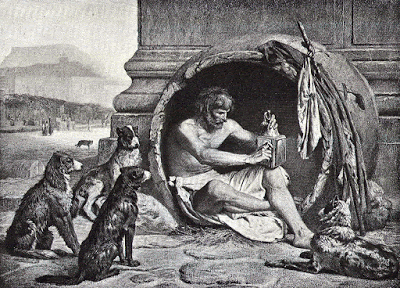

You don’t have to figure out which classifiers to include in your grid search and which parameter values to sweep over for each classifier – we do it for you.
Diogenes twitter pdf#
Users of Diogenes can find the best classifier, and find how the classifier performs with different-sized data sets, then make a pdf report of the results in only a few lines of code. For example, users of Scikit-Learn can use grid_search to find the best classifier. Instead, we do the “cobbling together” part so that our users can think of problems from a higher level. We do not duplicate the functionality of Pandas or Scikit-Learn.
Diogenes twitter code#
Most machine learning Python code cobbles together Pandas and Scikit-Learn to build custom graphs/pipelines/etc. You can then analyze that data to figure out which classifier/parameter combination work best for different evaluation metrics that you may care about.
Diogenes twitter software#
Building machine learning/data science systems often involves coming up with a software workflow and writing variations on very similar code.
Diogenes twitter update#
After averaging over a hundred copyright claims a day, the flow of new reports halted on April 15th, and Twitter has not made a submission to the database in 12 days.Īfter the article went up, Lumen put out a statement on Mastodon noting that Twitter had deliberately stopped sharing as their “data sharing policies are under review” and that “they will update Lumen once there is more information.At the Center for Data Science and Public Policy, we work on problems across different policy areas and develop machine learning (ML) solutions that span all these area, from education to public health to government transparency to public safety data. The biggest irregularity came earlier this month when Twitter’s self-reports abruptly stopped.

“My understanding is that they have a small team of people that work on this and it’s a largely automatic process.” “Historically, it seems Twitter has sent a copy of everything they’ve received to us,” says Adam Holland, who manages the project for the Berkman-Klein center. Notably, and importantly, just as Brandom was doing this research, Twitter abruptly stopped sharing this data: We already knew that Elon had caved in and was agreeing to take down accounts from journalists and activists in India, which old Twitter had drawn a line and said it refused to cross. That last column is “post-Elon.” So, again, Elon’s Twitter is now doing the very nonsense that Elon and his fans falsely thought old Twitter did. And, from the look of things, governments are fucking thrilled with this, seeing as the numbers of demands went way, way up. Thankfully, Russel Brandom over at Rest of World, realized that Twitter has still been automatically reporting government demand info to the good folks at the LumenDatabase… and from that found that Elon’s Twitter has been way more compliant in giving in to exactly what governments are demanding, both for removing content and for handing over information. Now, as we just reported, Twitter under Elon has stopped doing transparency reports, though it did release a ridiculous blog post that wasn’t “transparent” at all and literally said: “ Twitter’s compliance rate for these requests varied by requester country.” But provided no actual data on the compliance rate at all.


From that, you can see that Twitter complied with just 20% of requests from India, and 44% of the requests from Japan.Ĭlearly, the company made a real effort to evaluate the requests and their legal merit before making a decision.


 0 kommentar(er)
0 kommentar(er)
